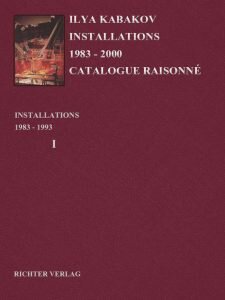The Targets
YEAR: 1991
CATALOGUE NUMBER: 41
PROVENANCE
The artist
Collection Museum für Moderne Kunst, Vienna
EXHIBITIONS
Vienna, Galerie Peter Pakesch
Ilya Kabakov. Die Zielscheiben, 12 Feb 1991 — 16 Mar 1991
Greve, Portalen, Køge Bugt Kulturhus
Ilya Kabakov. Storyteller. Installationer og ikkerealiserede projekter, 19 Jan 1996 — 17 Mar 1996
Aalborg, Nordjyllands Kunstmuseum
19 Apr 1996 — 9 Jun 1996
DESCRIPTION
Three paintings in a vertical format and 260 x 190 cm in size hang at small intervals from one another on one of the long walls of a large dwelling (12 x 8 meters). Each of them is executed with enamel paint on Masonite and has the appearance of the very popular announcement boards that line the streets or stand in front of some construction site.
The depictions on the paintings represent wide frames painted appropriately gray, bluish, and grayish-green, and in the middle is a white field with landscapes and texts under them. The painting on the left has crumpled newspapers glued on top of it, and the same kinds of crumpled balls are glued to the wall next to the painting and in the same disarray. In the same way, long wooden sticks are attached to the middle painting and the wall next to it. Pieces of rocks are on the painting to the right and on the wall. Corresponding to each of the paintings, there are balls of newspaper, sticks and rocks lying on the floor at a distance of a few meters from the paintings. Each such ‘target’ with its ‘ammunition’ is separated from the others by a wooden wall made up of boards. At the edge of each wall there are three tables with chairs where there are instructions and explanations of what is going on here and of what is required of the viewer.
CONCEPT OF THE INSTALLATION
Shooting ‘at the targets,’ murder, cursing. A unique ‘shooting gallery’ where people shoot at appearing figures of ducks, tigers, wolves. The ‘goals’ in this installation are two-fold: to throw (shoot) so as to destroy, smash the paintings, and the second, to destroy that which was painted on these paintings. On the first painting on the left, there is a small cabin with a person depicted and below is the caption: “I was born in this house on March 12, 1931.” This means that that place and that time when the ‘person’ (most likely this is the author) was born is subject to destruction. On the second painting is, ‘I lived here from …’ This idea is equally comprehensible. The same is on the third painting.
But the clumps, sticks and rocks also hit the gray background. And in this way, the very paintings themselves are destroyed, and not only what is depicted in them. And all of this takes place not in a ‘shooting gallery,’ but at an exhibition, and not during a happening afterwards when its results are demonstrated, but all is conceived from the very beginning as an ‘ordinary,’ normal painting exposition. In this case, the ‘museum’1 in the broad sense wins these actions on the paintings, and thanks to the ‘museum’ this very event itself becomes the subject of perpetual and stationary presence. The clumps, sticks, and rocks that are constantly ‘missing’ the paintings are present, they will perpetually be there where they hit the wall, they will perpetually lie on the floor at some distance from the unused instruments of murder. Art, so to speak, is not sensitive to its destroyers and, in fact, art includes objects of destruction in itself, in its own world.
Images
Literature









